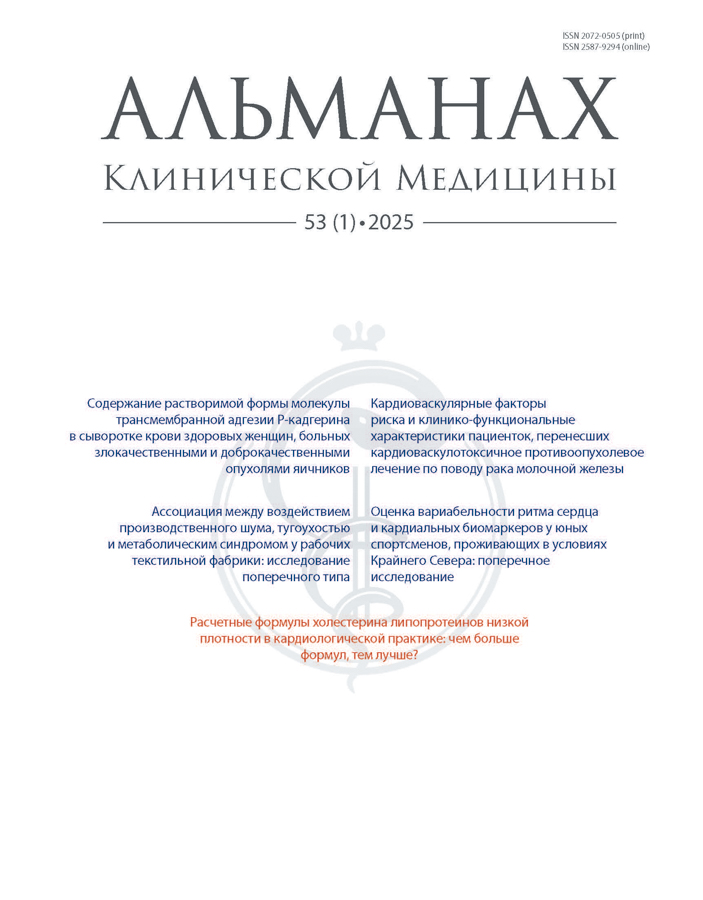Способ контроля толщины межжелудочковой перегородки при выполнении септальной миэктомии. Экспериментальное исследование
- Авторы: Гурщенков А.В.1, Селиванов М.В.1, Мухин Е.А.1, Сухова И.В.1, Дьяченко Я.А.1, Агаев Р.С.1, Майстренко А.Д.1, Новиков В.К.1, Кучеренко В.С.1, Гордеев М.Л.1
-
Учреждения:
- ФГБУ «Национальный медицинский исследовательский центр имени В.А. Алмазова» Минздрава России
- Выпуск: Том 47, № 4 (2019)
- Страницы: 310-317
- Раздел: ОРИГИНАЛЬНЫЕ СТАТЬИ
- URL: https://almclinmed.ru/jour/article/view/1094
- DOI: https://doi.org/10.18786/2072-0505-2019-47-039
- ID: 1094
Цитировать
Полный текст
Аннотация
Обосн
Обоснование. В настоящее время не существует методов интраоперационного контроля толщины межжелудочковой перегородки (МЖП) на остановленном и разгруженном сердце. Этим, по всей видимости, обусловлены неудовлетворительные результаты ряда операций септальной миэктомии.
Цель - экспериментально обосновать предложенный авторами способ контроля толщины МЖП при выполнении септальной миэктомии.
Материал и методы. В основу способа положен метод трансиллюминации. Экспериментальными моделями служили трупные свиные сердца, а также фрагменты человеческого миокарда, удаленные при операциях септальной миэктомии. Оценивалась толщина просвечиваемого миокарда в зависимости от величины локальной освещенности на входе в миокард и внешней освещенности операционного поля. Сопоставлены результаты 67 операций септальной миэктомии, выполненных в клинике ФГБУ «НМИЦ им. В.А. Алмазова» Минздрава России, и результаты 35 аналогичных экспериментальных операций, проведенных на трупных свиных сердцах с использованием предложенного метода контроля толщины МЖП.
Результаты. Построен график зависимости освещенности на входе в миокард и толщины просвечиваемого миокарда. После операций септальной миэктомии, выполненных традиционным способом, медиана разброса значений толщины миокарда составила 4 [3; 6] мм, а в эксперименте с использованием предложенного метода контроля толщины МЖП - 1 [1; 2] мм (р = 3 х 10-10).
Заключение. Способ контроля толщины МЖП при выполнении септальной миэктомии позволяет добиться необходимой толщины миокарда в зоне резекции со значительно большей точностью, чем при традиционном варианте исполнения.
Об авторах
А. В. Гурщенков
ФГБУ «Национальный медицинский исследовательский центр имени В.А. Алмазова» Минздрава России
Автор, ответственный за переписку.
Email: glebenmerz@mail.ru
ORCID iD: 0000-0001-8494-0646
Гурщенков Александр Викторович - кандидат медицинских наук, ассистент кафедры хирургических болезней.
188683, Ленинградская область, Всеволожский район, поселок им. Свердлова, 2-й микрорайон, 55-3, Тел.: +7 (921) 799 36 34
РоссияМ. В. Селиванов
ФГБУ «Национальный медицинский исследовательский центр имени В.А. Алмазова» Минздрава России
Email: fake@neicon.ru
ORCID iD: 0000-0002-5210-6398
Селиванов Максим Васильевич - врач-кардиохирург.
197341, Санкт-Петербург, ул. Аккуратова, 2
РоссияЕ. А. Мухин
ФГБУ «Национальный медицинский исследовательский центр имени В.А. Алмазова» Минздрава России
Email: fake@neicon.ru
ORCID iD: 0000-0002-1041-531X
Мухин Евгений Анатольевич - инженер-радиотехник.
197341, Санкт-Петербург, ул. Аккуратова, 2
РоссияИ. В. Сухова
ФГБУ «Национальный медицинский исследовательский центр имени В.А. Алмазова» Минздрава России
Email: fake@neicon.ru
ORCID iD: 0000-0002-7313-5307
Сухова Ирина Валентиновна - кандидат медицинских наук, врач-кардиолог, ведущий научный сотрудник.
197341, Санкт-Петербург, ул. Аккуратова, 2
РоссияЯ. А. Дьяченко
ФГБУ «Национальный медицинский исследовательский центр имени В.А. Алмазова» Минздрава России
Email: fake@neicon.ru
ORCID iD: 0000-0003-2777-8739
Дьяченко Яков Александрович - врач-кардиохирург, аспирант по специальности «Сердечно-сосудистая хирургия».
197341, Санкт-Петербург, ул. Аккуратова, 2
РоссияР. С. Агаев
ФГБУ «Национальный медицинский исследовательский центр имени В.А. Алмазова» Минздрава России
Email: fake@neicon.ru
ORCID iD: 0000-0001-9258-9649
Агаев Рамиль Саламович - врач-кардиохирург, аспирант по специальности «Сердечно-сосудистая хирургия».
197341, Санкт-Петербург, ул. Аккуратова, 2
РоссияА. Д. Майстренко
ФГБУ «Национальный медицинский исследовательский центр имени В.А. Алмазова» Минздрава России
Email: fake@neicon.ru
ORCID iD: 0000-0003-0335-4712
Майстренко Алексей Дмитриевич - кандидат медицинских наук, врач-кардиохирург.
197341, Санкт-Петербург, ул. Аккуратова, 2
РоссияВ. К. Новиков
ФГБУ «Национальный медицинский исследовательский центр имени В.А. Алмазова» Минздрава России
Email: fake@neicon.ru
ORCID iD: 0000-0002-4311-3086
Новиков Владимир Константинович - доктор медицинских наук, профессор кафедры хирургических болезней.
197341, Санкт-Петербург, ул. Аккуратова, 2
РоссияВ. С. Кучеренко
ФГБУ «Национальный медицинский исследовательский центр имени В.А. Алмазова» Минздрава России
Email: fake@neicon.ru
ORCID iD: 0000-0001-5493-5205
Кучеренко Владимир Сергеевич - доктор медицинских наук, профессор кафедры хирургических болезней.
197341, Санкт-Петербург, ул. Аккуратова, 2
РоссияМ. Л. Гордеев
ФГБУ «Национальный медицинский исследовательский центр имени В.А. Алмазова» Минздрава России
Email: fake@neicon.ru
ORCID iD: 0000-0001-5362-3226
Гордеев Михаил Леонидович - доктор медицинских наук, профессор, заведующий кафедрой хирургических болезней.
197341, Санкт-Петербург, ул. Аккуратова, 2
РоссияСписок литературы
- Hang D, Nguyen A, Schaff HV. Surgical treatment for hypertrophic cardiomyopathy: a historical perspective. Ann Cardiothorac Surg. 2017;6(4):318-28. doi: 10.21037/acs.2017.04.03.
- Morrow AG, Reitz BA, Epstein SE, Henry WL, Conkle DM, Itscoitz SB, Redwood DR. Operative treatment in hypertrophic subaortic stenosis. Techniques, and the results of pre and postoperative assessments in 83 patients. Circulation. 1975;52(1):88-102. doi: 10.1161/01.cir.52.1.88.
- Messmer BJ. Extended myectomy for hypertrophic obstructive cardiomyopathy. Ann Thorac Surg. 1994;58(2):575-7. doi: 10.1016/0003-4975(94)92268-3.
- Borisov KV. Right ventricle myectomy. Ann Cardiothorac Surg. 2017;6(4):402-9. doi: 10.21037/acs.2017.07.10.
- Wehman B, Ghoreishi M, Foster N, Wang L, D'Ambra MN, Maassel N, Maghami S, Quinn R, Dawood M, Fisher S, Gammie JS. Transmitral septal myectomy for hypertrophic obstructive cardiomyopathy. AnnThorac Surg. 2018;105(4): 1102-8. doi: 10.1016/j.athoracsur.2017.10.045.
- Quintana E, Schaff HV, Dearani JA. Transapical myectomy for septal hypertrophy not accessible through the aortic root. World J Pediatr Congenit Heart Surg. 2015;6(3):455-7. doi: 10.1177/2150135115589791.
- Kim JH. Tips for Successful Septal Myectomy in Patients with Hypertrophic Cardiomyopathy. Korean J Thorac Cardiovasc Surg. 2018;51(3): 227-30. doi: 10.5090/kjtcs.2018.51.3.227.
- Khalpey Z, Korovin L, Chitwood WR Jr, Poston R. Robot-assisted septal myectomy for hypertrophic cardiomyopathy with left ventricular outflow tract obstruction. J Thorac Cardiovasc Surg. 2014;147(5):1708-9. doi: 10.1016/j.jtcvs.2013.12.017.
- Musharbash FN, Schill MR, Henn MC, Dami-ano RJ Jr. Minimally invasive septal myectomy for hypertrophic obstructive cardiomyopathy. Innovations (Phila). 2017;12(6):489-92. doi: 10.1097/IMI.0000000000000421.
- Smedira NG, Lytle BW, Lever HM, Rajeswaran J, Krishnaswamy G, Kaple RK, Dolney DO, Black-stone EH. Current effectiveness and risks of isolated septal myectomy for hypertrophic obstructive cardiomyopathy. Ann Thorac Surg. 2008;85(1):127-33. doi: 10.1016/j.athoracsur.2007.07.063.
- Altarabsheh SE, Dearani JA, Burkhart HM, Schaff HV, Deo SV, Eidem BW, Ommen SR, Li Z, Ackerman MJ. Outcome of septal myectomy for obstructive hypertrophic cardiomyopathy in children and young adults. Ann Thorac Surg. 2013;95(2):663-9. doi: 10.1016/j.athoracsur.2012.08.011.
- 2014 ESC Guidelines on diagnosis and management of hypertrophic cardiomyopathy: the Task Force for the Diagnosis and Management of Hypertrophic Cardiomyopathy of the European Society of Cardiology (ESC). Eur Heart J. 2014;35(39):2733-79. doi: 10.1093/eurheartj/ehu284.
- 2011 ACCF/AHA guideline for the diagnosis and treatment of hypertrophic cardiomyopathy: a report of the American College of Cardiology Foundation/American Heart Association Task Force on Practice Guidelines. Circulation. 2011;124(24):e783-831. doi: 10.1161/CIR.0b013e318223e2bd.
Дополнительные файлы








